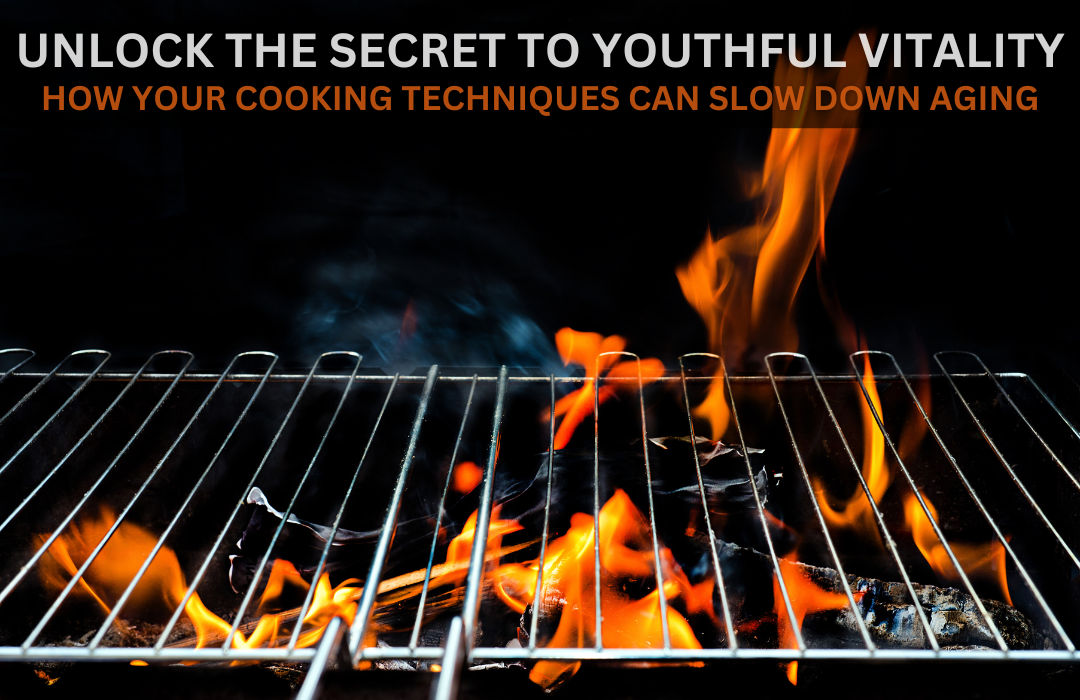
Unlock the Secret to Youthful Vitality: How Your Cooking Techniques Can Slow Down Aging
Brad King, MS, MFSSummer is almost here, so it’s time to spark up the BBQ, or is it? What if I told you, barbecuing your favourite foods could wreak havoc on your lifespan! It’s true, high heat cooking, especially exposing protein and fat to an open flame, can cause a nasty reaction that is easily transferred to your cells, just by eating overcooked food – read on…
Just like high heat from that BBQ causes your favourite foods to turn dark and crispy on the outside (bring on the char!), once we consume these foods, we end up introducing a type of char to our very own cells. Couple this with excess sugar in our bloodstream, and we end up creating nasty chemical reactions that essentially "cook" our tissues from the inside out. So, while you're enjoying those blackened ribs and that ice-cold lemonade on a hot summer day, understand that all that charred food and sweet taste of sugar might be the very things that accelerate the aging process and robe you of your youthful glow.
The above scenario is referred to as glycation, the process in which excess sugar molecules in the body attach to proteins and fats, forming harmful molecules known as advanced glycation end products, or AGEs. AGEs can lead to premature aging by permanently damaging protein structures like collagen and elastin, which are essential components of skin, blood vessels, and other connective tissues. In fact, this is one of the major reasons we get wrinkles!
Excess carbohydrates, especially the processed ones, eventually break down into simple sugars that stick to the body’s many cells, causing a browning or cooking reaction (AGEs). To give you an example of how damaging these AGEs can be, if excess sugar is left uncontrolled in the body, it can attach to the cells of your eyes, causing cataracts, and when sugar attaches to nerve cells, they can cause neuropathy, or nerve damage. This is one of the major reasons diabetics experience so much nerve damage!
A Simple Blood Test
A single blood marker called hemoglobin A1C (HbA1C or A1C for short) is a measurement of how much damage from glycation is occurring in the body. Hemoglobin is the protein found in red blood cells responsible for delivering oxygen to your trillions of cells, and A1C is a type of hemoglobin that has glucose stuck to it. A normal healthy level of A1C is below 5.7%, however, when levels of A1C rise, it indicates that more glucose is sticking to your proteins, which can lead to a variety of health problems.
If your goal is to lower AGEs in the body, and it should be, it's essential to focus on diet and lifestyle changes, especially reducing the consumption of processed and sugary foods, increasing the intake of antioxidant-rich foods and nutrients (i.e. organic fruits and vegetables).
Humic & Fulvic Acids
One beneficial natural remedy that can help lower AGEs is humic-fulvic acid complexes. These natural compounds that are millions of years old, have been shown to reduce inflammation and oxidative stress in the body, which are major contributors to the formation of AGEs. Additionally, humic and fulvic acids work by chelating or binding to heavy metals and other toxins, which can also contribute to the glycation reaction.
Humic-fulvic acid complexes can easily be taken in supplement form, either in capsule or liquid. They should only be purchased from reputable companies that do stringent in-house and third-party testing, in order to ensure their quality. Aside from this, they should always be supplemented together, as in a natural humic-fulvic acid complex, rather than isolated and found only as humic or fulvic acid.
Additionally, incorporating other natural remedies such as herbal teas (i.e. green tea), as well as spices like cinnamon, ginger, rosemary and turmeric, are also potent inhibitors of AGEs. If you do use high heat when cooking, as in barbecuing, try adding plenty of spices to your foods to limit the damage and don’t forget to take a couple of capsules of humic-fulvic acid complex right before eating.
In summary, glycation is a harmful process that can lead to premature aging effects in the body. By focusing on low sugar diets, medium to low heat cooking, exercise and supplementation with humic-fulvic acid complexes, individuals can work to reduce the glycation reaction and promote overall health and well-being.
4 Tips to Eliminate AGEs Fast:
1) Avoid processed foods: Processed foods are often high in sugar, refined carbohydrates, and unhealthy fats, all of which can contribute to the formation of AGEs.
2) Cook with low-heat methods: Cooking at high temperatures can lead to the formation of AGEs in food. To reduce the formation of AGEs in your diet, try cooking with low-heat methods such as steaming or poaching.
3) Choose lean protein sources: Reducing the intake of high-fat animal proteins can help to reduce the formation of AGEs in the body.
4) Consume natural anti-glycation compounds: There are several natural compounds that can help to combat the formation of AGEs, some of the best of which are; humic-fulvic acid complexes, spices, carnosine, benfotiamine, and pyridoxamine.
References